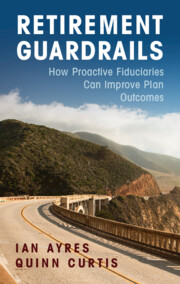Book contents
- Retirement Guardrails
- Retirement Guardrails
- Copyright page
- Contents
- Figures
- Tables
- Acknowledgments
- Introduction
- 1 The Case for Proactive Fiduciaries
- 2 Fees and Dominated Funds
- 3 Of Lawsuits and Letters
- 4 What More Fiduciaries Should Learn
- 5 What More Fiduciaries Should Learn
- 6 What Fiduciaries Can Do to Remedy Menu Misuse
- 7 How Should Fiduciaries Trade Off Divergent Participant Interests?
- 8 Can Streamlining and Guardrailing Mitigate Allocation Error?
- 9 The Growing Misuse of Brokerage Windows
- Conclusion
- Index
Introduction
Published online by Cambridge University Press: 08 June 2023
- Retirement Guardrails
- Retirement Guardrails
- Copyright page
- Contents
- Figures
- Tables
- Acknowledgments
- Introduction
- 1 The Case for Proactive Fiduciaries
- 2 Fees and Dominated Funds
- 3 Of Lawsuits and Letters
- 4 What More Fiduciaries Should Learn
- 5 What More Fiduciaries Should Learn
- 6 What Fiduciaries Can Do to Remedy Menu Misuse
- 7 How Should Fiduciaries Trade Off Divergent Participant Interests?
- 8 Can Streamlining and Guardrailing Mitigate Allocation Error?
- 9 The Growing Misuse of Brokerage Windows
- Conclusion
- Index
Summary
Scores of lawsuits have pushed retirement plan sponsors to shorter, easier-to-navigate menus, but – as Ian Ayres and Quinn Curtis argue in this work – we’ve only scratched the surface of retirement plan design. Using participant-level plan data and straightforward tests, Ayres and Curtis show how plan sponsors can monitor plans for likely allocation mistakes and adapt menus to encourage success. Beginning with an overview of the problem of high costs and the first empirical evidence on retirement plan fee lawsuits, they offer an overview of the current plan landscape. They then show, based on reforms to a real plan, how streamlining menus, eliminating pitfalls, and adopting static and dynamic limits on participant allocations to certain risky assets or “guardrails” can reduce mistakes and lead to better retirement outcomes. Focusing on plausible, easy-to-implement interventions, Retirement Guardrails shows that fiduciaries need not be limited to screening out funds but can design menus to actively promote good choices.
Information
- Type
- Chapter
- Information
- Retirement GuardrailsHow Proactive Fiduciaries Can Improve Plan Outcomes, pp. 1 - 13Publisher: Cambridge University PressPrint publication year: 2023
